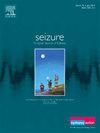Apparent efficacy of NMDAR antagonist use as a targeted therapy for status epilepticus in an infant with ATP1A2-related developmental epileptic encephalopathy
IF 2.7
3区 医学
Q2 CLINICAL NEUROLOGY
引用次数: 0
Abstract
Background
N-methyl-D-aspartate receptor (NMDAR) blockers are important to control seizures in patients with refractory status epilepticus. ATP1A2 gene plays a role in protecting neurons from glutamate and NMDAR-related excitotoxicity. Although variations in the ATP1A2 gene are classically associated with hemiplegic migraine and alternating hemiplegia, in recent years, ATP1A2 variations have been reported with developmental and epileptic encephalopathy (DEE-98) and status epilepticus. Case report: An 11-month-old girl whose neuromotor development regressed following the onset of seizures at five months of age was admitted to the intensive care unit with a diagnosis of status epilepticus. Her seizure was partially responsive to ketamine, and she became seizure-free when memantine, another NMDA receptor blocker, was added to the treatment. Her WES analysis was completed during the second week of memantine treatment, revealing a heterozygous, de-nova, c.2432C>G variant in the ATP1A2 gene.
Conclusion
ATP1A2-related DEE-98 is seen as very rare, and some of the patients with DEE-98 died due to refractory status epilepticus. The ATP1A2 gene is important for protecting neurons from glutamate and NMDAR-related excitotoxicity. We want to present the infant to emphasize the importance of targeted therapy with MNDARs in ATP1A2-related seizures, even during the status epilepticus period.
求助全文
约1分钟内获得全文
求助全文
来源期刊

Seizure-European Journal of Epilepsy
医学-临床神经学
CiteScore
5.60
自引率
6.70%
发文量
231
审稿时长
34 days
期刊介绍:
Seizure - European Journal of Epilepsy is an international journal owned by Epilepsy Action (the largest member led epilepsy organisation in the UK). It provides a forum for papers on all topics related to epilepsy and seizure disorders.
 求助内容:
求助内容: 应助结果提醒方式:
应助结果提醒方式:


